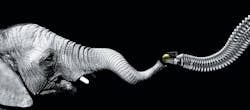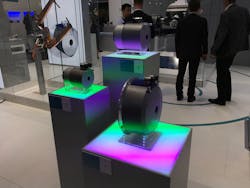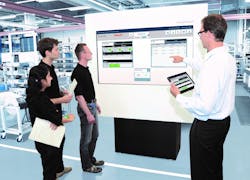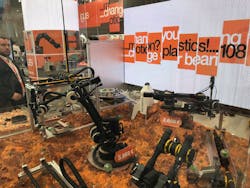A Look Back at Hannover Messe 2018, Part 1
The world’s largest manufacturing Expo was about a month ago, but before we move onto all our other show coverage, I wanted to recap some of the booths visited and technology launched. Every year at Hannover the show shines its spotlight on a chosen partner country. This year Mexico will have the opportunity to present its new technologies, investment opportunities, innovative growth strategies, and research projects to the movers and shakers of global industry.
Back in February 2017 Jeff Burnstein, president of A3, talked about Mexico becoming the next global player in the automation arena. With $156 billion of direct foreign investment, Mexico has shown an exponential increase in exports over the last six years. With this success, and now the attention Mexico is getting from hosting Hannover Messe, it looks like the country is poised to grow as it shows off their abilities and technology at this show.
The show still featured the countries and companies that show up year after year. This year Festo, Bosch Rexroth, Wittenstein, and igus were showing off a lot of technology that is changing the way we think of manufacturing.
Festo
As usual Festo had a large booth that looked equal parts sophisticated manufacturing facility and mad scientist’s laboratory. Festo’s employee development program is one of the most successful I’ve seen. In short, employees build robotic animals (sometimes mimicking humans too) to better their skills and the company’s products.
This year the company decided that one innovative robotic animal wasn’t enough. While Festo was still showing off its cool elephant trunk-like pneumatic arm with a fish fin inspired gripper, it also had a robotic spider crawling along the floor and a large bat flying over the audience.
The arm is comprised of 12 pneumatic sections that fill to create multiple degrees of freedom and flexibility not possible with other arms that use solid joints. The gripper was inspired by a fish fin. The geometry will wrap around an object rather than having datums close on it. This makes it easier to handle sensitive objects like eggs and light bulbs.
Festo was also showing off the new Bionic Workspace, Bionics4Education, and SupraMotor. The SupraMotor is getting a lot of attention recently. As technology advances, controlled levitation has become possible. Also called Quantum locking, or flux pinning, Festo succeeded in constructing a superconductive drive with electrical direct cooling. Measuring only about a meter in length and up to 23 centimeters in diameter, this unit is highly compact. The drive makes use of the fact that electricity within an appropriately cooled superconductor is transmitted without loss. This allows a strong magnetic field to be generated with very high currents which can be used for the motor.
A TED Talk presented an example of this, saying a 2 mm thick by 76.2 mm diameter semiconductor (about 0.08 by 3 in.) could lift a small car effortlessly with this effect. However, scaling the technology and the amount of cooling necessary makes this technology more for clean rooms, medical equipment like MRIs, and power applications.
Wittenstein
Moving from new motors to new gearboxes, the new Galaxie gearbox lineup blends the mechanical gear systems with modern encoder and interconnected features. The lineup features three sizes: the compact Galaxie D in size 085, for use in smaller cutting heads or handling axes where special requirements apply regarding torsional rigidity and freedom from backlash; the new ultra-flat Galaxie DF in sizes 110 and 135, which saves up to 30% of the normal installation length; and the Galaxie GH, with its optional right-angle input stage.
The flexible encoder interfaces allow Galaxie to be easily integrated into existing machine concepts such as machine tools, cutting heads, and robot welding guns. The Galaxie gearboxes collect operating data that can be transmitted to an IoT cloud using a Galaxie Drive System equipped with sensors. This data can be accessed anywhere and on any device throughout the drive lifecycle, regardless of the control system. While this was exciting, there is never a moment to rest as it was time for a stage presentation from Bosch Rexroth.
The Galaxie offers the benefits of a gearbox while minimizing the negatives. Backlash is a problem with indirect drives, but this new elliptical-like design can change direction with a high degree of precision, accuracy, and repeatability.
Bosch Rexroth
Next Bosch Rexroth was presenting its vision of the factory of the future. A large audience was crowded around Bosch Rexroth’s stage. Six characters, or robots, zoomed around on stage while a presenter talked about them.
- The ActiveCockpit was the data collector—an IT-supported individual product assembly and process optimization.
- The IoT Gateway was the personal trainer—an I4.0 solution with new possibilities. In addition, this won the 2018 Engineers Choice Award.
- The APAS Assistant was the team player—Bosch Rexroth’s present collaborative robot based on KUKA.
- The ActiveShuttle was the delivery guy—a smart, autonomous system that transports dollies that are loaded with small load carriers.
- The XDK Sensor was the messenger—the XDK from Bosch enables a rapid development of sensor-based IoT solutions.
- Nexeed was the data player—software and services for production and logistics.
Together these large robots put on a short show to introduce each, but the short presentation barely scratched the surface of what could be done with these technologies. I saw firsthand that Bosch tests its technology in its own shops to make sure all the products add value to a company when I toured its factory in Bethlehem, Pa.
The intelligent ActiveAssist assembly assistant system guides employees through everything from multi-variant assembly tasks to batch sizes of one. The interactive communication platform ActiveCockpit collects, filters, and processes data from complete production lines in real time for systematic process optimization.
The idea behind all these tools is to imagine a factory where you could change everything apart from the floor, roof, and walls within a few days (or even hours) to offer full flexibility, individuality, and scalability. This is what Bosch believes the factory of the future is about. The requirements for future production are marked by increasingly short product life cycles, smaller batch sizes, and individual product design and forms. There was much more happening in the booth, but I had to get to igus to see what new technologies it was releasing.
igus
igus was another large booth with a lot to get through. I talked about Robolink from igus being a simple online software that lets anyone built a custom robot arm. Its cost can change greatly, but it is possible to build a custom robot arm for a few thousand dollars. It seems like just yesterday, yet they have already added to this with the new Apiro.
Doubling down on the low-cost modular solutions, design engineers can choose from three lubrication-free worm gears for standard movement, inverted movement, and linear movement. For the user, there are practically no limits anymore, with solutions ranging from the simple linear robot to complex humanoid and animatronic robots.
There were various robots performing tasks in a Mars-like setting with the cost right on the front. This fast modular robot design can not only be up and running quickly and cost-effectively, but they can be taken apart and used in a different way if production changes in the future.
Beyond this, igus launched a new delta robot arm, presented more on its smart plastics, and presented all its connected devices. Known for its wire carriers, igus has developed wireless devices to detect any unnecessary wear, push, or pull, along with breakage. This offers predictive maintenance and can alert a technician that something is going wrong before a problem or excessive wear can occur. It seemed like every time I turned a corner in the massive booth there was a new technology or product. Igus has a broader portfolio than most people are probably aware.
This article covers only a few of the booths at Hannover, so stay tuned for my next installment. I took one of the fair’s guided tours, which allowed me to see companies I don’t normally get a chance to check out.





